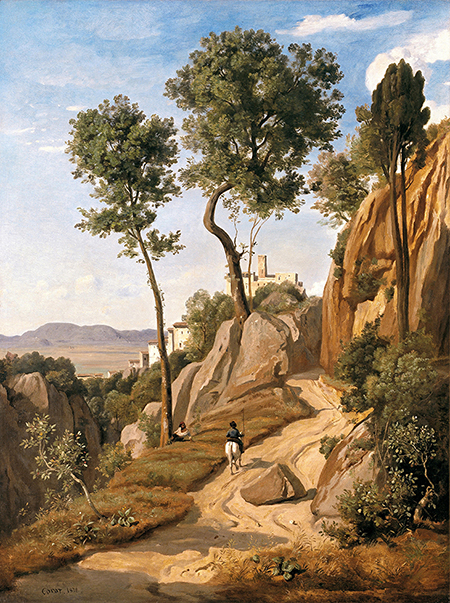
In a world inundated with contemporary and emerging art, the recently refurbished Timken Museum in San Diego’s Balboa Park provides some relief with its presentation of figurative artworks from the 14th to the 20th century. Yet the museum’s ambiance is unlike that of other museums showing traditional art, with their imposing lobbies and hallways. The user-friendly, 57-year-old Timken features five accessible galleries, each featuring paintings from a different country, organized chronologically with detailed didactics, and one gallery reserved for temporary exhibitions.
The collection originated with heiress sisters Amy and Anne Putnam. They moved to San Diego in the early 20th century. With their inherited fortune, they began acquiring Old Master paintings, donating them at first to the Fine Arts Gallery of San Diego, now the San Diego Museum of Art. Decades later, they established the Putnam Foundation, mandating that it continue acquiring significant works of art.
In 1951, the Putnam Foundation purchased Petrus Christus’s "Death of the Virgin," the largest work done by the 15th-century Flemish artist. From 1952 to 1956, additional paintings by historical luminaries such as Rembrandt, Peter Paul Rubens, Jacques-Louis David, Jacob van Ruisdael, Bartolomé Esteban Murillo, Frans Hals, Jean-Baptiste-Camille Corot, Jean-Honoré Fragonard, François Clouet, Paolo Veronese, Pieter Breughel the Elder, and others were acquired. An agreement with the Timken Foundation to construct a new art venue in Balboa Park came soon after.
Originally called the Timken Art Gallery, the 10,400-square-foot mid-century building opened in 1965, presenting a counterpoint to the Spanish Colonial Revival architecture style pervasive in the Park. The modernist building, constructed with travertine marble, bronze and glass, is a work of art itself, with its aesthetically designed entryway, full-length windows connecting the interior with gardens, patterned designs on doors and polished bronze baseboards.
Megan Pogue, the museum’s Executive Director explains, "Quite provocative at its inception, the juxtaposition of an important Old Masters collection in an iconic, mid-century modern building within Balboa Park continues to create intrigue and curiosity.” Derrick Cartwright, Ph.D., the Timken’s Director of Curatorial Affairs, adds that the museum staff and volunteers strive to make the experience of viewing great art accessible, transparent, and engaging to the broadest possible public.
The Timken’s French gallery features two companion paintings by Nicolas de Largillière, “Portrait of Barthélemy-Jean-Claude Pupil” and “Portrait of Marguerite de Sèvel” (both 1729). The first depicts Pupil wearing his wig and legal robes while holding a book. The second work features his aristocratic wife in a dress with an embossed, jeweled bodice, touching a musical score. Cartwright adds that another among the Timken’s important French works is Corot’s “View of Volterra” (1838). Detailing the rugged countryside of the Italian town, it is a fine example of a pre-Impressionist plein-air painting. Two other works, François Boucher’s “Lovers in a Park” (1758) and Fragonard’s “Blindman’s Buff” (1775-80) represent, Cartwright explains, the elegance and carefree attitudes of the ancien regime on the cusp of the French Revolution.
The Italian gallery features several ravishing paintings. These include Veronese’s “Madonna and Child with Saint Elizabeth, the Infant Saint John the Baptist, and Saint Catherine” (1565-70). Didactics explain, “Veronese arranges the figures in a stately flow of interconnecting forms and renders them using a rich play of light and a perfect balance of warm and cool colors.” “Portrait of a Lady in a Green Dress” (1530) by Bartolomeo Veneto presents an elegantly dressed woman, adorned with a headpiece of human hair decorated with blue and gold ribbon.
The Dutch/Flemish gallery contains its own treasures. Rembrandt’s “Saint Bartholomew” (1657) portrays a moody apostle holding a butcher’s knife as a symbol of his martyrdom. “Parable of the Sower (1557), by Breughel illuminates a bucolic landscape with a river, a mountain range and a peasant scattering seeds. The seeding aspect, a gift to humanity, is also a parable for the museum, which offers free admission and a welcoming atmosphere.
Also in the gallery, Gabriel Metsu’s “Girl Receiving a Letter” (ca. 1658) will be the centerpiece in the upcoming fall exhibition, “Exchanging Words: Women and Letters in Seventeenth-Century Dutch Genre Painting,” about women absorbed in intellectual pursuits, such as reading and writing. The painting will be surrounded by several works from the same period, on loan from the Leiden Collection, one of the largest collections of 17th century Dutch art in private hands.
The Russian Icons gallery contains rare religious artworks, most of them painted on wood panel. The 15th century “The Royal Gates” depicts Christ as the King of Glory, with four panels showing evangelists, Matthew, Mark, Luke, and John. The 16th century “St. Basil with Scenes from His Life” illustrates the fourth-century archbishop who established monastic life in the Eastern church. Also from the 16th century, “The Ascension of Our Lord Jesus Christ” is a detailed scene of Christ with his followers on the Mount of Olives.
The Timken’s American paintings are among its newest. Thomas Moran’s “Opus 24: Rome, from the Campagna, Sunset” (1867) was painted four years before the artist traveled to the American west to record the magnificent natural vistas of our country. “Opus 24” is a prescient example of his later works. Albert Bierstadt’s “Cho-looke, the Yosemite Fall” (1864) illustrates the natural majesty of the falls the year that President Lincoln designated Yosemite Valley the first public trust, 26 years before it was designated a national park.
Two American seascapes, “Castine Harbor and Town” (1851) by Fitz Henry Lane, and “An American Ship in Distress” (1841) by Thomas Birch depict the sea and an expanse of sky, during stillness in the first painting, and amidst a violent storm in the second. These artists pay homage in their work to the Romantic artists immediately preceding them who observed the relationship between the natural world and humanity, believing that the struggle to comprehend nature was heroic. The Timken’s collection helps us understand that this cannot be taken for granted.
